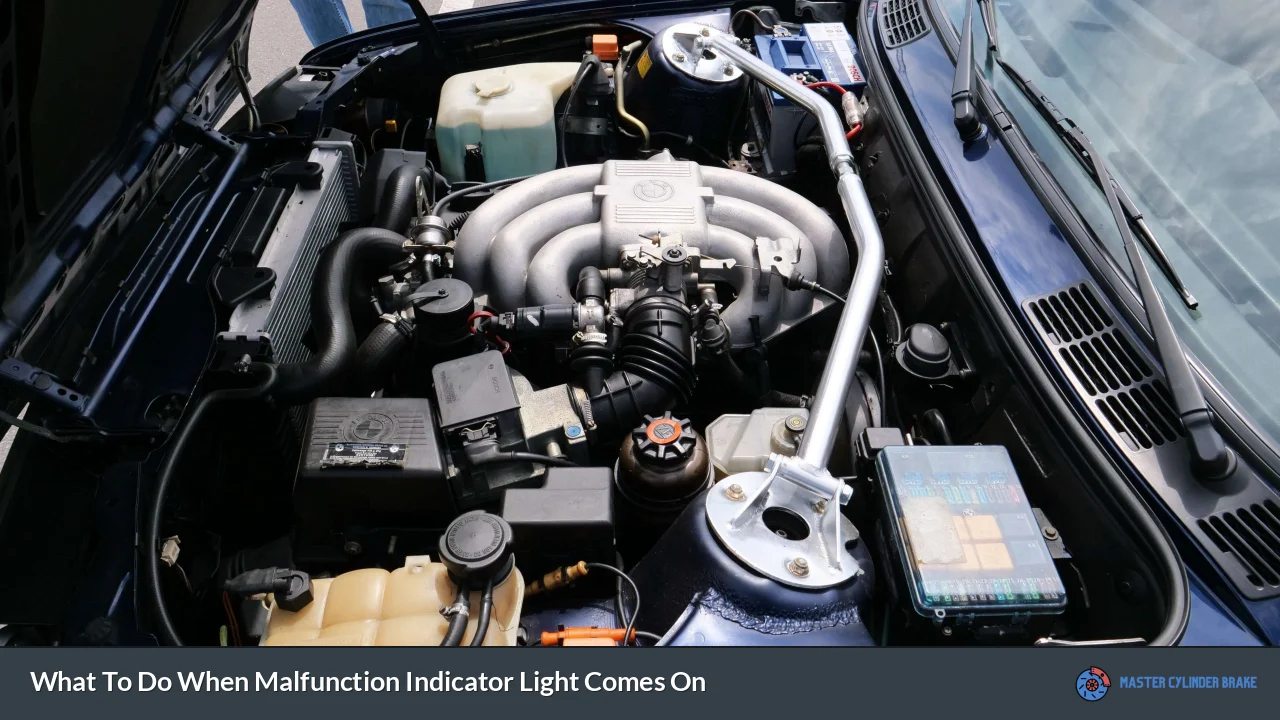What do you do when the Malfunction Indicator Light (MIL) suddenly illuminates on your dashboard? It’s a situation that can leave any driver feeling apprehensive. Don’t panic! This article will guide you through the steps to take when faced with this unexpected warning signal.
When the Malfunction Indicator Light comes on, it means that your vehicle’s onboard diagnostic system has detected an issue with one or more of its components. This light is often represented by an engine icon or the letters “MIL” or “Check Engine.” While it may be tempting to ignore it or hope it goes away on its own, it’s crucial to address the problem promptly to prevent further damage and ensure your safety on the road.
The first step is to stay calm and avoid making sudden maneuvers that could endanger yourself or other drivers. Safely pull over to the side of the road or find a suitable location to park your vehicle. Turn off the engine and give it a few minutes to cool down before proceeding.
Once you’ve stopped, it’s time to assess the situation. Check for any obvious signs of trouble, such as smoke, leaks, or unusual noises. If everything appears normal, it’s still essential to have the problem diagnosed by a professional. While some issues may be minor and easily fixable, others could indicate more significant problems that require immediate attention.
Before heading to the mechanic, consider a few factors. Is the Malfunction Indicator Light flashing or solid? A flashing light typically indicates a severe problem that may result in catalytic converter damage. In such cases, it’s advisable to have your vehicle towed to a trusted repair shop rather than risking further harm by driving it.
Remember, the Malfunction Indicator Light can signify a wide range of problems, from a loose gas cap to a faulty sensor or a malfunctioning engine component. Only a qualified technician equipped with specialized diagnostic tools can accurately identify the underlying issue.
When faced with an illuminated Malfunction Indicator Light, prioritize your safety by pulling over, assessing the situation, and seeking professional help. Ignoring the light or delaying repairs can lead to more extensive and costly damage down the road. Stay proactive and address the issue promptly to keep your vehicle running smoothly and ensure a worry-free driving experience.
Decode the Mystery: Expert Tips on Responding to a Malfunction Indicator Light
Do you ever get that sinking feeling when a warning light pops up on your car’s dashboard? We’ve all been there. One of the most notorious and perplexing warning lights is the Malfunction Indicator Light (MIL). It’s like a cryptic message from your vehicle, leaving you wondering what’s wrong and how to address it. But fear not! In this article, we’ll unravel the mystery behind the MIL and provide you with expert tips on how to respond effectively.
So, what exactly is the Malfunction Indicator Light? Well, think of it as your car’s way of saying, “Houston, we have a problem!” It’s a small icon—usually shaped like an engine—that lights up on your dashboard to indicate a potential issue with your vehicle’s engine, emission control system, or other vital components. Ignoring it can lead to costly repairs or even breakdowns, so it’s crucial to take action promptly.
When the MIL illuminates, the first step is to remain calm. Don’t panic and start assuming the worst. Instead, find a safe spot to pull over and assess the situation. Check for any obvious signs of trouble, such as strange noises, excessive smoke, or a sudden loss of power. These observations can help you provide useful information to a mechanic later on.
Once you’re safely parked, it’s time to decode the mystery behind the MIL. One common mistake many people make is relying solely on guesswork or outdated advice found online. Instead, consult the trusted source of information—the owner’s manual specific to your vehicle. It contains invaluable insights into what the MIL signifies and may even offer troubleshooting steps tailored to your car’s make and model.
Remember, the MIL can illuminate for various reasons, ranging from minor issues like a loose gas cap to more significant problems like a faulty sensor. If you’re confident in your automotive knowledge, you may attempt simple fixes like tightening the gas cap. However, for complex issues or if the light persists, it’s best to seek help from a certified mechanic.
The Malfunction Indicator Light should never be ignored. By remaining calm, consulting your owner’s manual, and seeking professional assistance when needed, you can effectively respond to this mysterious warning signal. Remember, just as a doctor decodes symptoms to diagnose an ailment, decoding the MIL can prevent further damage and keep your car running smoothly on the road.
Ignition Alert: How to Handle the Unexpected Appearance of the Malfunction Indicator Light
Have you ever experienced that heart-stopping moment when your car’s dashboard suddenly lights up like a Christmas tree, with the dreaded Malfunction Indicator Light (MIL) glaring at you? It’s a surprise no one welcomes, but don’t panic just yet! In this article, we’ll explore what the Malfunction Indicator Light is, what it signifies, and most importantly, how to handle it like a pro.
The Malfunction Indicator Light, often referred to as the check engine light, is a small yet powerful warning sign that something isn’t quite right in your vehicle’s engine system. It’s like a secret language between your car and you, communicating issues that need attention. When the MIL illuminates, it indicates that your car’s onboard diagnostic system has detected a potential problem related to the engine, emission control system, or other crucial components.
So, what should you do when this unexpected light catches you off guard? First, take a deep breath and remind yourself not to panic. The appearance of the Malfunction Indicator Light doesn’t necessarily mean your car is on the verge of a breakdown. However, it does require your attention and prompt action.
The best course of action is to address the issue sooner rather than later. Begin by checking if any other warning lights are illuminated simultaneously. If there are no other urgent warnings, you can continue driving, but it’s advisable to drive gently and avoid pushing your vehicle to its limits until you can assess the situation.

Next, consider investing in an OBD-II scanner, a handy tool that allows you to read the trouble codes stored in your car’s computer system. These trouble codes provide valuable clues about the specific issue triggering the Malfunction Indicator Light. Once you retrieve the code, consult your vehicle’s manual or search online for more information on the particular code and its implications.
Remember, while it may be tempting to ignore the Malfunction Indicator Light or cover it with a piece of tape, it’s not a wise move. Ignoring the issue could potentially lead to more significant and costly problems down the road. Instead, take control of the situation by having your vehicle inspected by a qualified mechanic who can diagnose and resolve the underlying problem.
Encountering the Malfunction Indicator Light unexpectedly can be a stressful experience. However, by staying calm, taking proactive steps like using an OBD-II scanner, and seeking professional help when needed, you can navigate through this situation with confidence. Remember, your car is trying to communicate with you—listen carefully and address its concerns promptly to ensure a smooth and trouble-free journey.
Roadside SOS: What Every Driver Should Know About the Malfunction Indicator Light
Introduction:
You’re cruising down the road, wind in your hair, and a smile on your face. Suddenly, an ominous orange light catches your eye on the dashboard – it’s the Malfunction Indicator Light (MIL). Panic sets in as you wonder what could be wrong with your beloved vehicle. Take a deep breath and let’s unravel the mystery behind this warning signal that every driver should know about.
Understanding the Malfunction Indicator Light:
The Malfunction Indicator Light, often referred to as the check engine light, is like a secret code hidden within your vehicle’s computer system. When something goes awry, this light springs into action, alerting you to a potential issue that requires attention. It’s important not to ignore it, as doing so could worsen the problem and lead to costly repairs.

What does it mean?
Now, you might be wondering, “What triggers this light?” The truth is, there are numerous reasons why the Malfunction Indicator Light may illuminate. It could be as simple as a loose gas cap or something more complex like a faulty oxygen sensor or catalytic converter. The light serves as a general warning, indicating that a fault has been detected in one or more of your vehicle’s systems.
Taking action when it lights up:
When faced with the Malfunction Indicator Light, the best course of action is to remain calm and take it seriously. Start by checking if the gas cap is securely fastened, as a loose cap can trigger the warning. If that doesn’t solve the issue, it’s time to seek professional help. Visiting a trusted mechanic or automotive technician who possesses the necessary diagnostic equipment can identify the specific problem and perform the required repairs.
Preventing future problems:
While the Malfunction Indicator Light can be daunting, there are steps you can take to minimize the chances of encountering it. Regular vehicle maintenance, including oil changes, air filter replacements, and scheduled inspections, goes a long way in preventing potential issues. Additionally, keeping an eye on your vehicle’s performance, such as unusual noises or reduced fuel efficiency, can help you catch problems early and avoid costly repairs down the road.

In conclusion:
When Your Car Talks: Deciphering the Message Behind the Malfunction Indicator Light
When you’re cruising down the road, enjoying the wind in your hair and the freedom of the open road, the last thing you want is for your car to throw a wrench in your plans. But fear not! Your trusty ride has a way of communicating with you through its very own language, transmitted via the enigmatic Malfunction Indicator Light (MIL). So buckle up and let’s decipher the message behind this mysterious dashboard symbol.
Picture this: you’re driving along, feeling like you’re on top of the world, when suddenly, the MIL illuminates, casting an ominous glow on your dashboard. Panic may set in, but remember, your car is just trying to tell you something important. The MIL, often shaped like an engine or simply displaying the letters “Check Engine,” is your vehicle’s way of saying, “Hey, pay attention!”
Now, what could be the cause of this unexpected warning light? Well, it’s like your car’s version of a secret code. It could mean anything from a minor hiccup to a more serious issue that requires immediate attention. Is it a faulty oxygen sensor, a loose gas cap, or perhaps a misfiring engine? Without proper decoding, it’s hard to say.
But fear not, intrepid driver! When faced with the enigma of the MIL, there are steps you can take to unravel its cryptic message. First, don’t panic and pull over if it’s safe to do so. Take a moment to assess the situation. Is your car behaving strangely? Are there any other warning signs or symptoms? These clues can help you navigate the mysteries of the MIL.
Next, consider seeking professional assistance. A visit to your trusted mechanic will ensure that the issue is properly diagnosed and addressed. They have the know-how and specialized tools to delve into your car’s inner workings and pinpoint the source of the trouble. Remember, decoding the MIL’s message is not a task suited for DIY guesswork.
